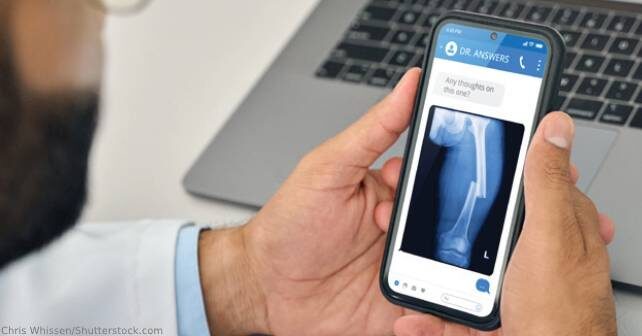
Case
A 69-year-old man presents from the assisted living facility with hip pain following a fall. He has a history of dementia and is oriented to name only. Radiographs show a left mid-shaft femur fracture. You call the on-call orthopedist, who asks you to text the radiographs.
Explore This Issue
ACEP Now: Vol 41 – No 10 – October 2022Question: Can you text the images to the orthopedist?
There are numerous resources for answers to clinical questions. Clinical textbooks, such as Tintinalli’s Emergency Medicine: A Comprehensive Study Guide, or Rosen’s Emergency Medicine, are valuable resources for studying and answering basic clinical questions. Search engines may provide more current information. Online review sources, such as UpToDate, are also rapidly accessible. However, administrative questions can be more challenging to answer in a timely manner.
National organizations may provide guidance for important clinical questions and may inform local policy development and implementation. For this question, let’s go to national organizations for guidance.
The American Medical Association (AMA) has an expansive online policy compendium, available for search on their Policy Finder at https://policysearch.ama-assn.org/policyfinder. To provide guidance on this specific issue, there is a policy entitled Privacy and Confidentiality H-315.978:1
The AMA policy states that where possible, informed consent should be obtained before personally identifiable health information is used for any purpose. However, in those situations where specific informed consent is not practical or possible, either (1) the information should have identifying information stripped from it or (2) an objective, publicly accountable entity must determine that patient consent is not required after weighing the risks and benefits of the proposed use. Re-identification of personal health information should only occur with patient consent or with the approval of an objective, publicly accountable entity.
The U.S. Department of Health and Human Services (HHS) provides guidance on Health Insurance Portability and Accountability Act (HIPAA) compliance.2
Does the HIPAA Privacy Rule permit a doctor, laboratory, or other health care provider to share patient health information for treatment purposes by fax, e-mail, or over the phone?
Yes. The Privacy Rule allows covered health care providers to share protected health information for treatment purposes without patient authorization, as long as they use reasonable safeguards when doing so. These treatment communications may occur orally or in writing, by phone, fax, e-mail, or otherwise.
ACEP has a policy compendium of over 200 policies, available at acep.org/policystatements. Choose the category of policy you are looking for, in this case “Ethics.” There is a policy entitled “Audiovisual Recording in the Emergency Department.”3 Relevant positions of this policy include:
- Recording or producing still images, audio files, or audiovisual materials. These can be made using both organizationally and personally owned equipment and electronic devices.
- Health care institutions ought to provide HIPAA-compliant methods to store and securely transmit health care sensitive recordings.
- Health care organizations and institutions ought to recognize that HIPAA-compliant audiovisual materials may benefit patients. Creation, promotion, and use of audiovisual educational materials may help patients understand and recall vital parts of their ED experience and discharge instructions.
Practical Considerations
Administrative issues can be addressed using national and local policies. Short Message Service (SMS) messaging is not considered secure or HIPAA-compliant. Institutions should provide encryption enabled messaging systems to provide a HIPAA compliant method of communication by mobile phone. HIPAA compliant images without identifiers should be used. If a securely encrypted texting service is not available, images should not be texted.
Dr. Marco is professor of emergency medicine at Penn State Health-Milton S. Hershey Medical Center and associate editor of ACEP Now.
References
- Policy finder. AMA. Available at: https://policysearch.ama-assn.org/policyfinder/detail/. Accessed September 9, 2022.
- US Department of Health and Human Services: HIPAA for professionals. Available at: https://www.hhs.gov/hipaa/for-professionals/faq/482/does-hipaa-permit-a-doctor-to-share-patient-information-for-treatment-over-the-phone/index.html. Accessed June 10, 2022.
- American College of Emergency Physicians: Available at: https://www.acep.org/patient-care/policy-statements/audiovisual-recording-in-the-emergency-department/. Accessed June 7, 2022.
Pages: 1 2 | Multi-Page




No Responses to “Practical Considerations When Sharing Clinical Images for Treatment Purposes”